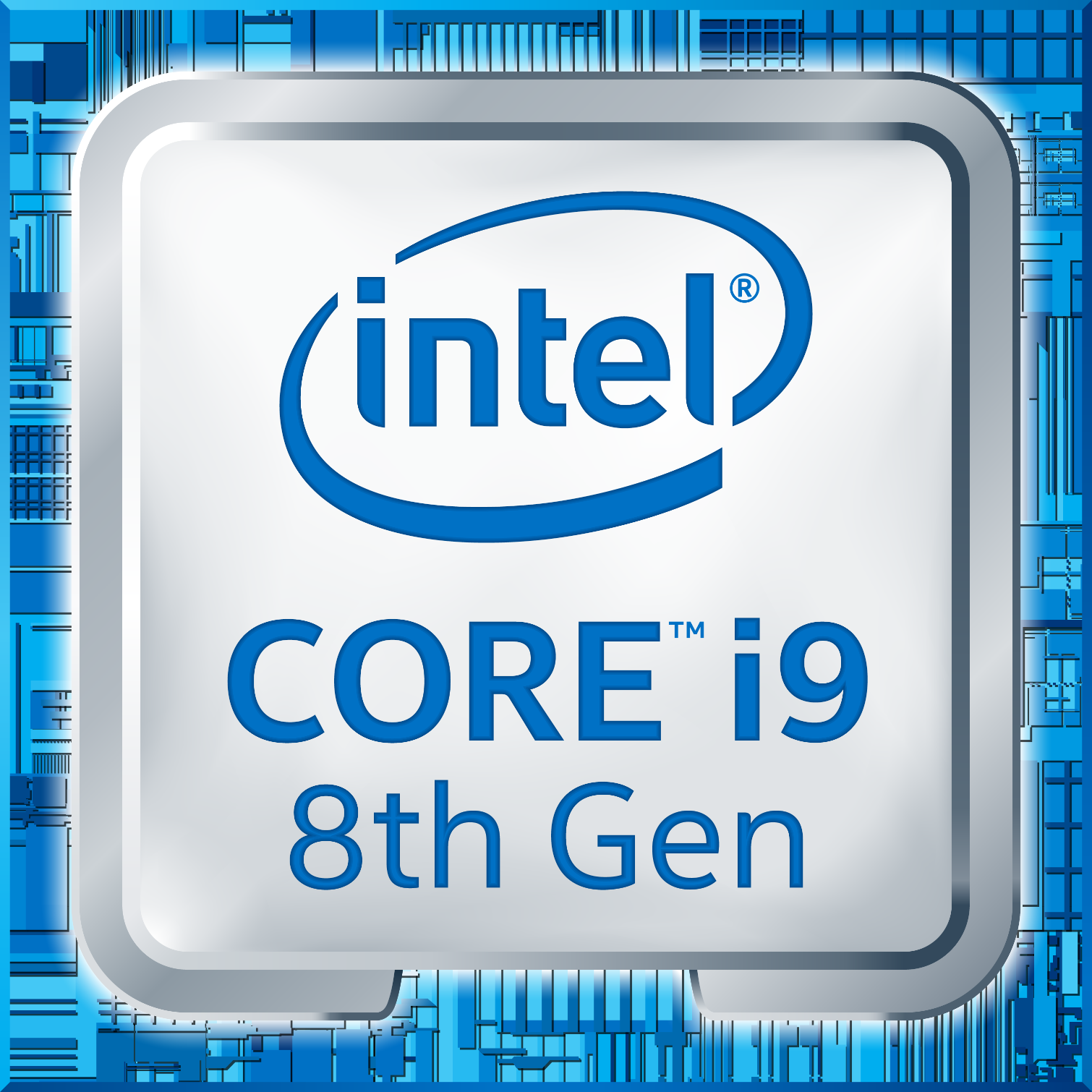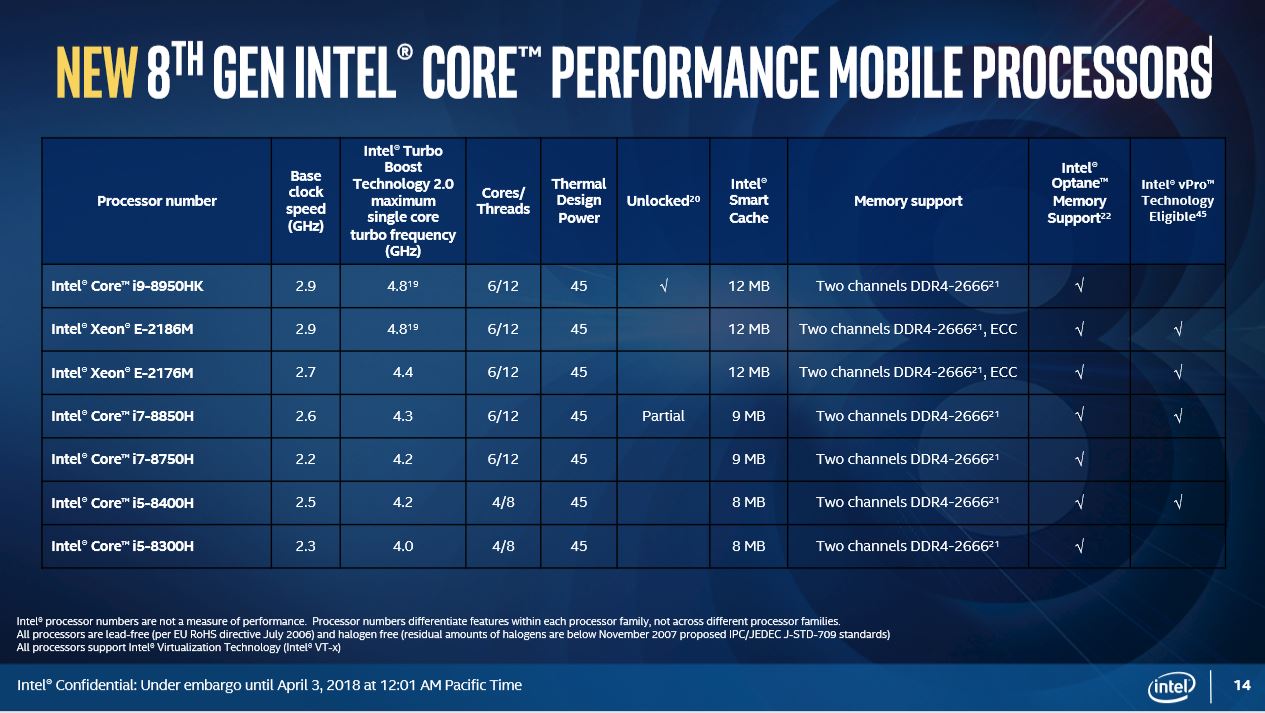Intel Details Mobile 6-Core Coffee Lake Core i9s & Mainstream CPUs With Iris Plus Graphics
Coffee Lake has arrived for the mobile segment. Intel announced new six-core, 12-thread Coffee Lake processors that serve as the flagships of its eighth-gen mobile processor lineup.
The processors are the first six-core models designed for laptops, and the flagships come with Intel's new Thermal Velocity Boost, which is an expansion of the TurboBoost feature. The feature allows the Core i9-8950HK to boost up to 4.8 GHz on a single core, which is the highest boost frequency of any of Intel's processors (desktop models included).
Intel carves the laptop segment into different categories, with the 45W H-series being the top-shelf lineup aimed at the high-performance gaming and workstation crowd, while the 28W U-series serves the mainstream mobile market. The new Core i9 sits atop the H-series pyramid, but Intel also announced new 6C/12T Xeon and Core i7 processors and 4C/8T Core i5s that round out the 45W family. Intel is also introducing new U-series Core i7 and i5 models that come packing Iris Plus graphics.
Intel's introduction of the Core i9 series to notebooks continues the company's focus on boosting core counts that we initially saw with the launch of its 8th-generation U-Series processors. Those processors brought twice the cores and threads of the previous-generation models. That was a needed improvement in light of AMD's renewed push into the laptop market with its Ryzen Mobile processors. This generation also finds Intel improving single-threaded boost frequencies. Additionally, all the new processors ride on the mobile 300-series chipset that boasts several new advances.
Intel's new 6C/12T models give Intel the leading core counts in the mobile space. Intel claims the Coffee Lake processors are up to 59% faster for 4K video editing. The Thermal Velocity Boost (TVB) brings Intel's 14nm++ process to bear for more lightly-threaded tasks, like gaming, which Intel claims is up to 41% faster.
H-Series Processors
The 6C/12T parts are the most obvious change to the lineup due to their two additional cores. Surprisingly, Intel managed to keep the processors within the 45W TDP envelope, but that requires a reduced 2.9GHz base frequency with the Core i9 and Xeon E-2186M processors (compared to the previous-gen's 3.1 GHz base). The reduced base frequencies are an acceptable tradeoff for the increased core counts, but they're outweighed by a huge increase in the single-core TurboBoost frequency that now tops out at 4.8GHz. Naturally, the processor will outstrip the 45W TDP rating during boost activity. Intel will also allow OEMs to set a 35W cTDP setting for the new processors. Intel no longer shares multi-core turbo specifications.
Intel improved the memory subsystem from DDR4-2400 to DDR4-2666 for all the H-Series models. The Core i9, Xeon E-2186M, and Xeon E-2176M increase to 12MB of L3 cache as a byproduct of the increased core counts. Intel apparently disables 3MB of cache on the Core i7-8850H and i7-8750H for product segmentation purposes. The Core i5 models come with four cores, thus wielding the same 8MB of cache as their predecessors. All the H-Series processors feature 16 PCIe 3.0 lanes to provide enough lanes for graphics cards and other additives.
Get Tom's Hardware's best news and in-depth reviews, straight to your inbox.
The Xeon models also support ECC memory and vPro (a lone Core i5 model also supports vPro). Intel also announced new capabilities with its Optane products. In a new tactic for Intel, the company allows OEMs to partially overclock the Core i7-8550H processor up to 4 bins (400 MHz), but it doesn't appear to be a user-configurable option.
| CPU | GPU EUs | GPU Base Frequency | GPU Turbo Frequency |
|---|---|---|---|
| i9-8950HK | 24 | 350 | 1200 |
| E-2186M | 24 | 350 | 1200 |
| E-2176M | 24 | 350 | 1200 |
| i7-8850H | 24 | 350 | 1150 |
| i7-8750H | 24 | 350 | 1100 |
| i5-8400H | 24 | 350 | 1100 |
| i5-8300H | 23 | 350 | 1100 |
The new processors all come outfitted with Intel's Gen9 graphics engine and 24 EUs.
Intel's new Thermal Velocity Boost (TVB) algorithms are an added layer of TurboBoost that allows the processor to boost its frequency up to 200MHz higher than the typical single-core boost frequency and 100MHz higher for multi-core boosts. This feature is active only on the Core i9 and Xeon E-2186M, but Intel is considering adding it to the rest of its lineup. The opportunistic boost kicks in when the processor falls below a 50C temperature threshold, so much like the standard TurboBoost frequencies, it isn't guaranteed in all conditions.
Interestingly, Intel lists the boost frequency for the Core i9 and Xeon E-2186M in the chart as "Intel TurboBoost 2.0 Maximum single core turbo frequency," but we found this in the footnotes:
Includes the effect of Intel Thermal Velocity Boost feature which opportunistically and automatically increases clock frequency by up to 200 MHz if the processor is at a temperature of 50°C or lower and turbo power budget is available. The frequency gain and duration is dependent on the workload (best for bursty workloads), capabilities of the individual processor, and the processor cooling solution. Frequencies may reduce over time and longer workloads may start at the max frequency but drop as processor temperature increases
Intel doesn't list the actual TurboBoost 2.0 frequencies that you would be much more likely to encounter during normal use. We've reached out to Intel for clarification and will update accordingly.
U-Series Processors
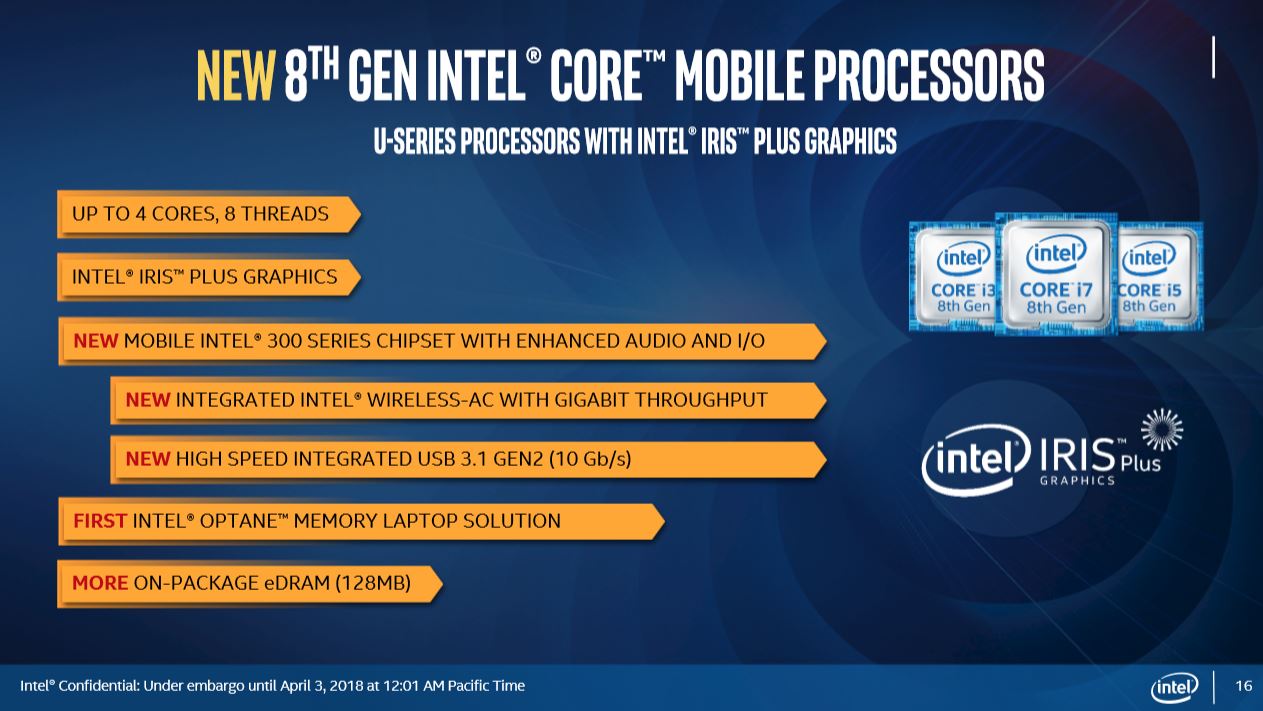

Intel added new premium 28W U-Series processors, but they don't replace the existing models. Intel splits its existing U-Series processors into 15W and 28W TDPs, so the new 28W models are geared for a higher level of performance for the mainstream market. The 4C/8T Core i7 model features 8MB of cache and an impressive 4.5 GHz boost frequency, while the Core i5 models step back to 6MB of cache. The 2C/4T Core i3 model weighs in with 4MB of cache. All of the processors feature the same DDR4-2400 frequency as their predecessors.
| CPU | GPU EUs | GPU Base Frquency | GPU Turbo Frequency |
|---|---|---|---|
| i7-8559U | 48 | 300 | 1200 |
| i5-8269U | 48 | 300 | 1100 |
| i5-8259U | 48 | 300 | 1050 |
| i3-8109U | 47 | 300 | 1050 |
These new processors come outfitted with Gen9 graphics and 128MB of eDRAM, which is DRAM that is integrated on-die with the processor. This affords a performance advantage by providing more bandwidth to the graphics engine, especially when paired with the hefty allotment of 48 EUs (except for the i3-8109U). These processors should provide an intermediate level of graphics performance that slots between Intel's normal integrated graphics and the Kaby Lake-G processors with AMD's Radeon Vega.
300-Series Chipset


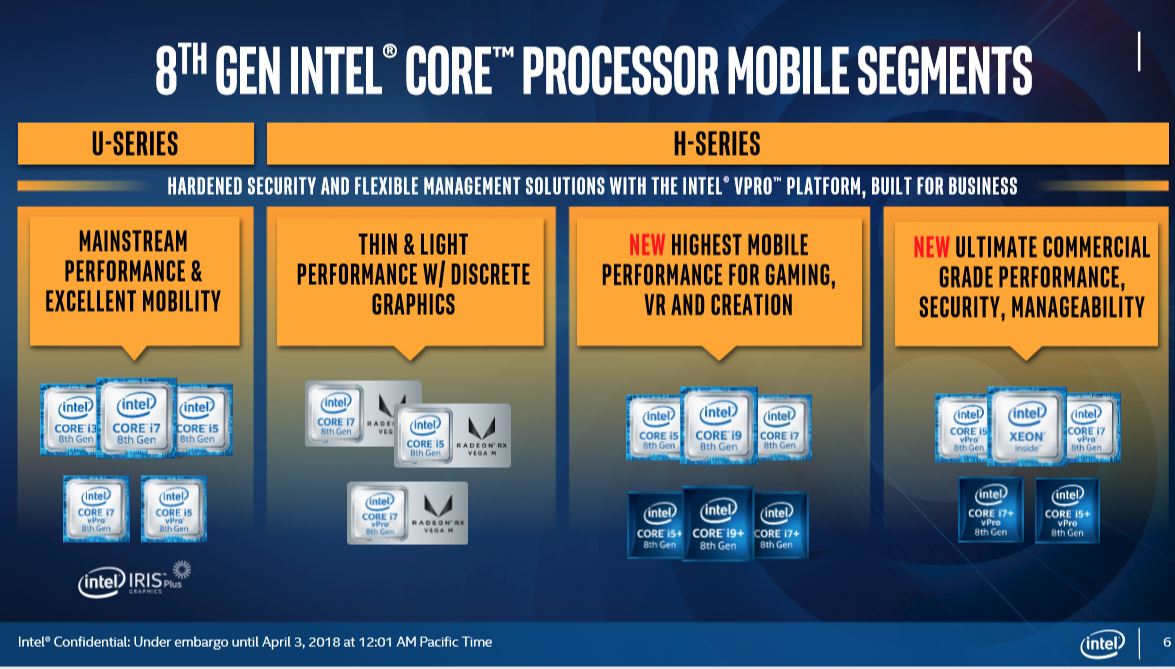
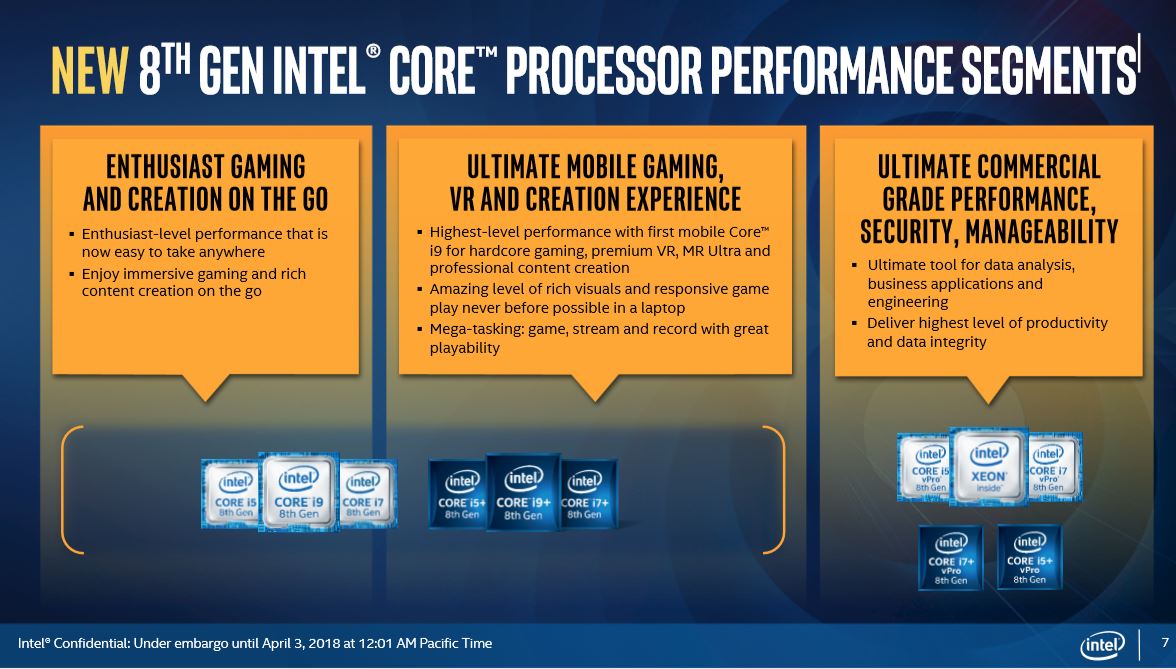
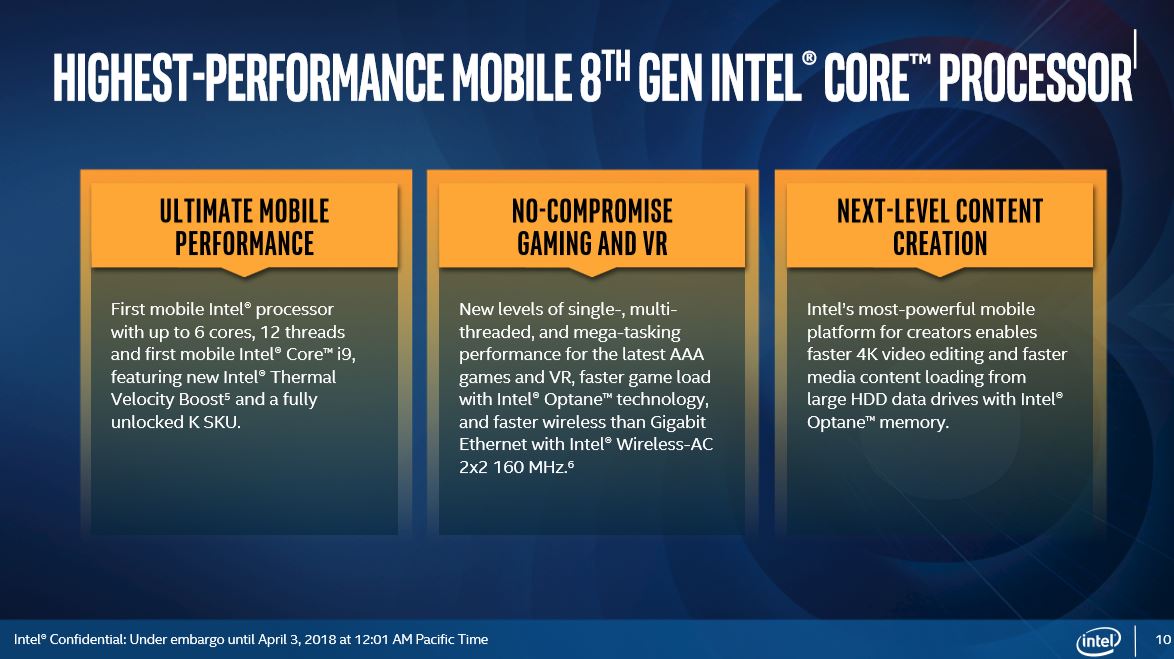

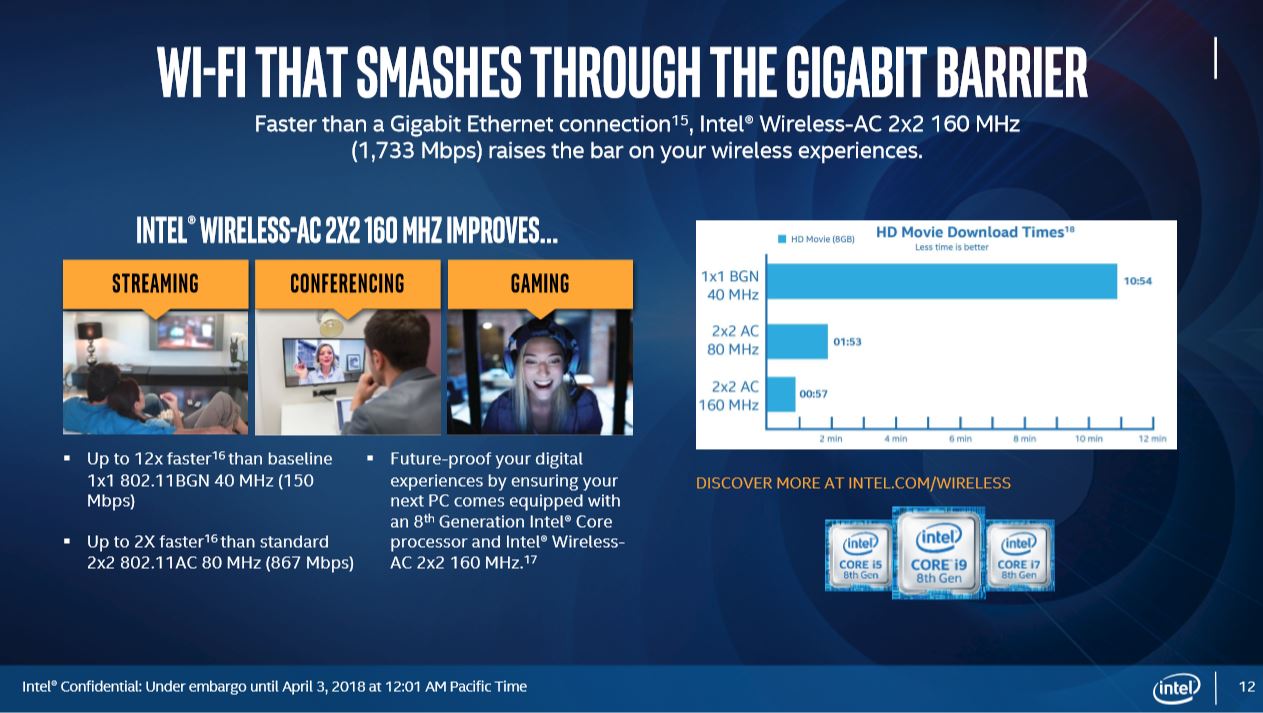
Intel's latest lineup brings the mobile chipset up to par with the desktop. The new processors use the 300-series chipset that offers a range of improvements that include integrated USB Gen 3.1 Gen2 with the full 10Gbps of throughput. Intel says that some laptops will come with two or more ports with the speedy interface.
Intel also doubled Wi-Fi capabilities with support for Wireless-AC 2x2 160 MHz. Intel integrated the MAC into the chipset, but it still requires a PHY for operation, thus reducing cost and avoiding additional FCC requirements for the chipset. Intel offers its own CNVi module as the other half of the integrated solution, but the company also supports third-party solutions. This fast connection, which debuted with the Gemini Lake processors, provides more bandwidth than a wired connection with up to 1,733 Mbps, but it requires a router that supports the feature. Intel also improved the audio DSP (it now supports five simultaneous voice-activated applications) and said that it improved audio quality, though the improvements aren't entirely defined at this time. Contrary to widespread speculation, Intel hasn't brought Thunderbolt 3 connectivity on-die yet.
Intel also provided us with its internal performance data compared to 1-year-old and 3-year-old systems. This launch marks the first time that Intel has used results that represent the impact of the Spectre/Meltdown patches. We know that older processors suffer from a much larger performance hit from the patches, so while these results represent actual post-patch performance, Intel likely gains a small bump in several of the benchmarks that compare older Haswell systems to the new processors. Intel says that all of these products will ship with the appropriate patches installed. We've included the test notes below in a click-to-expand format.

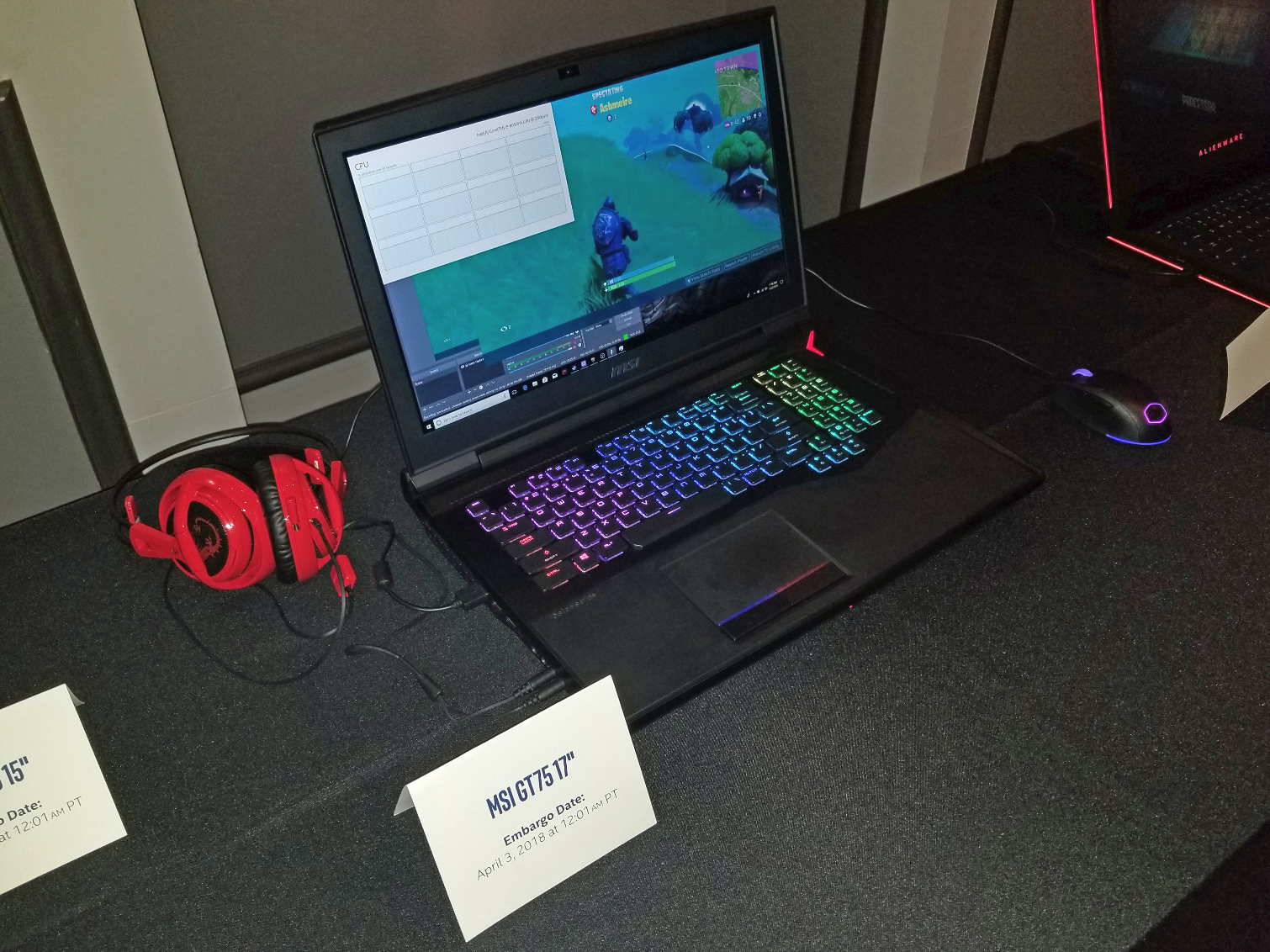


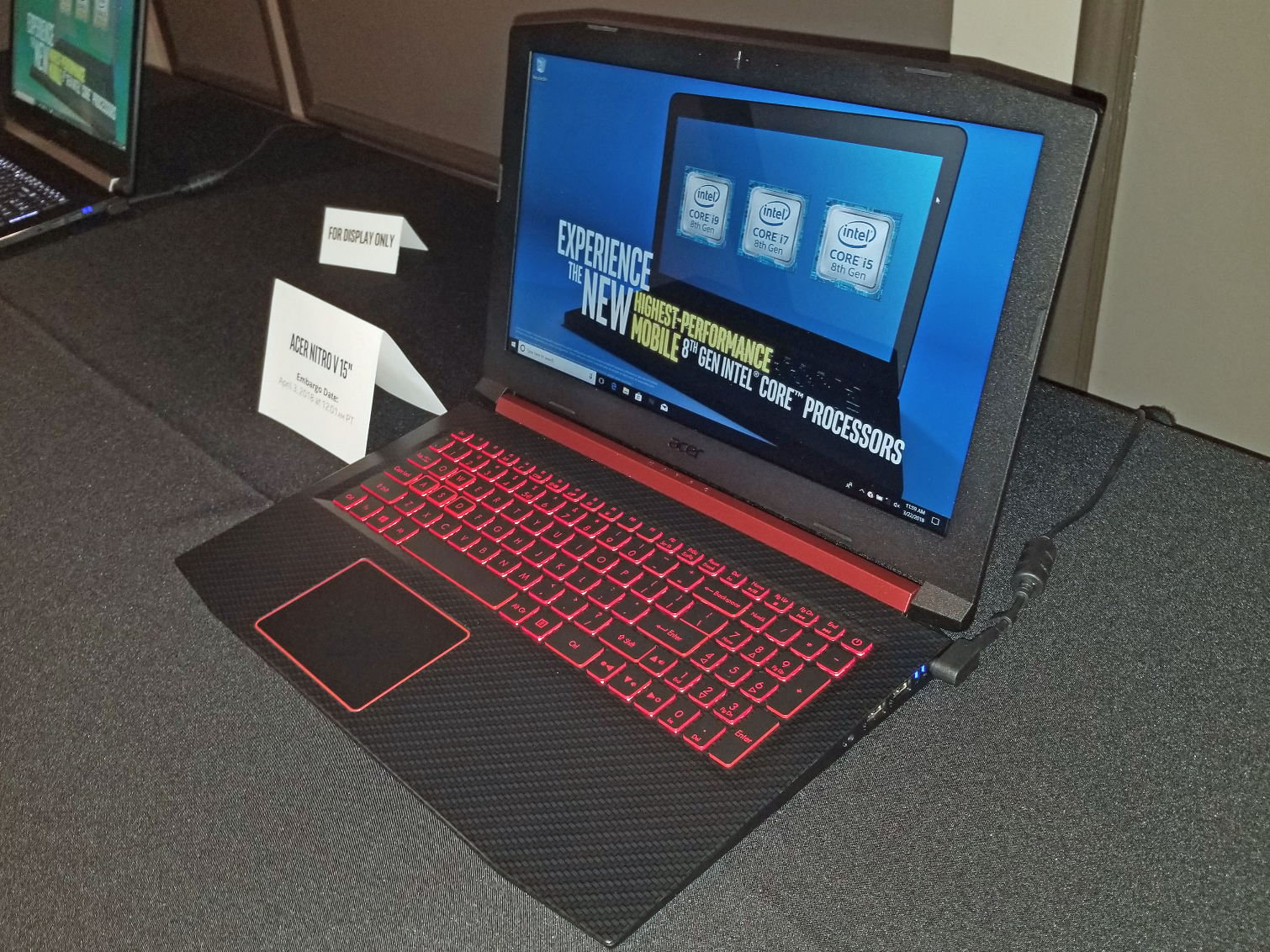
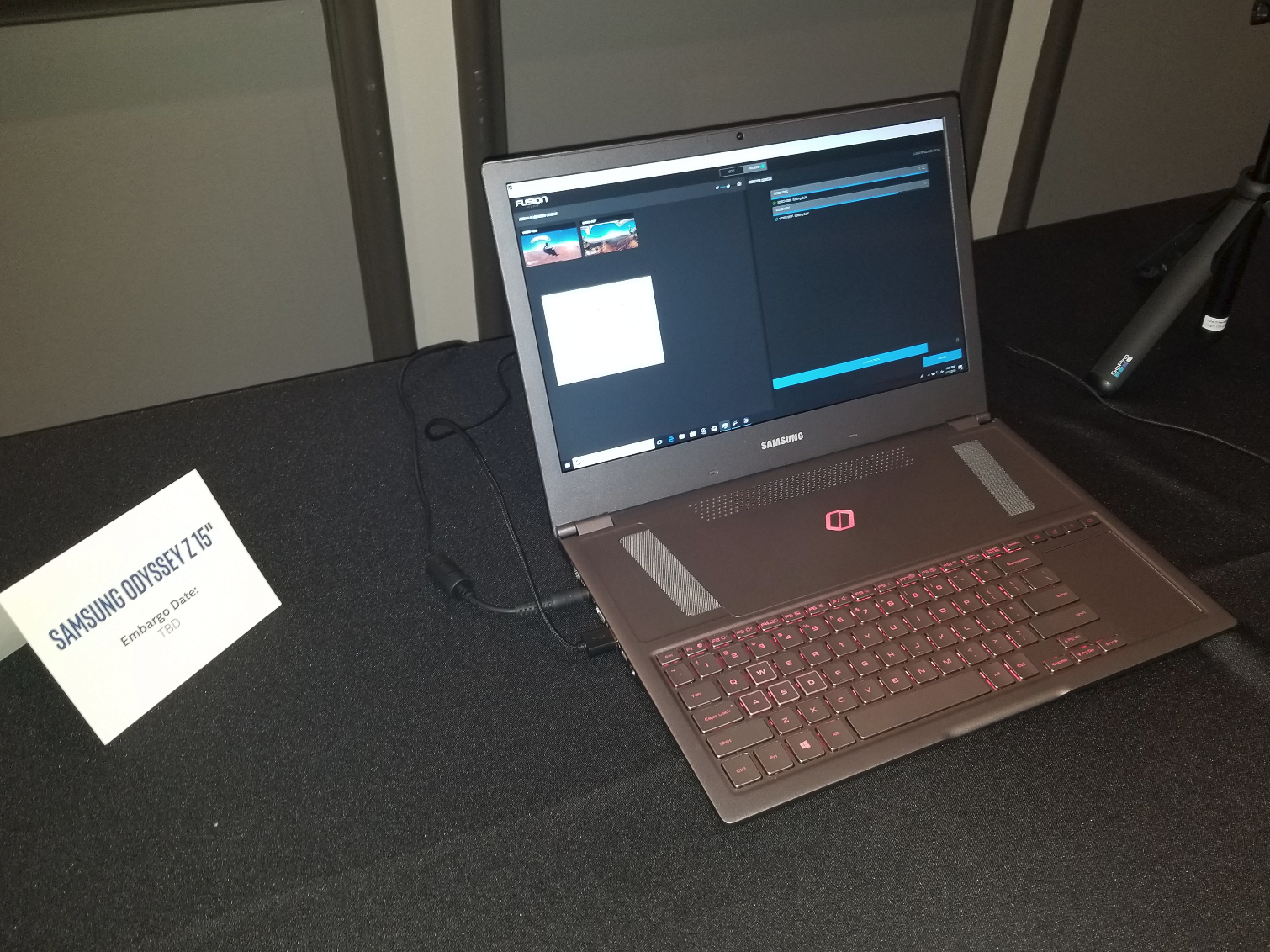
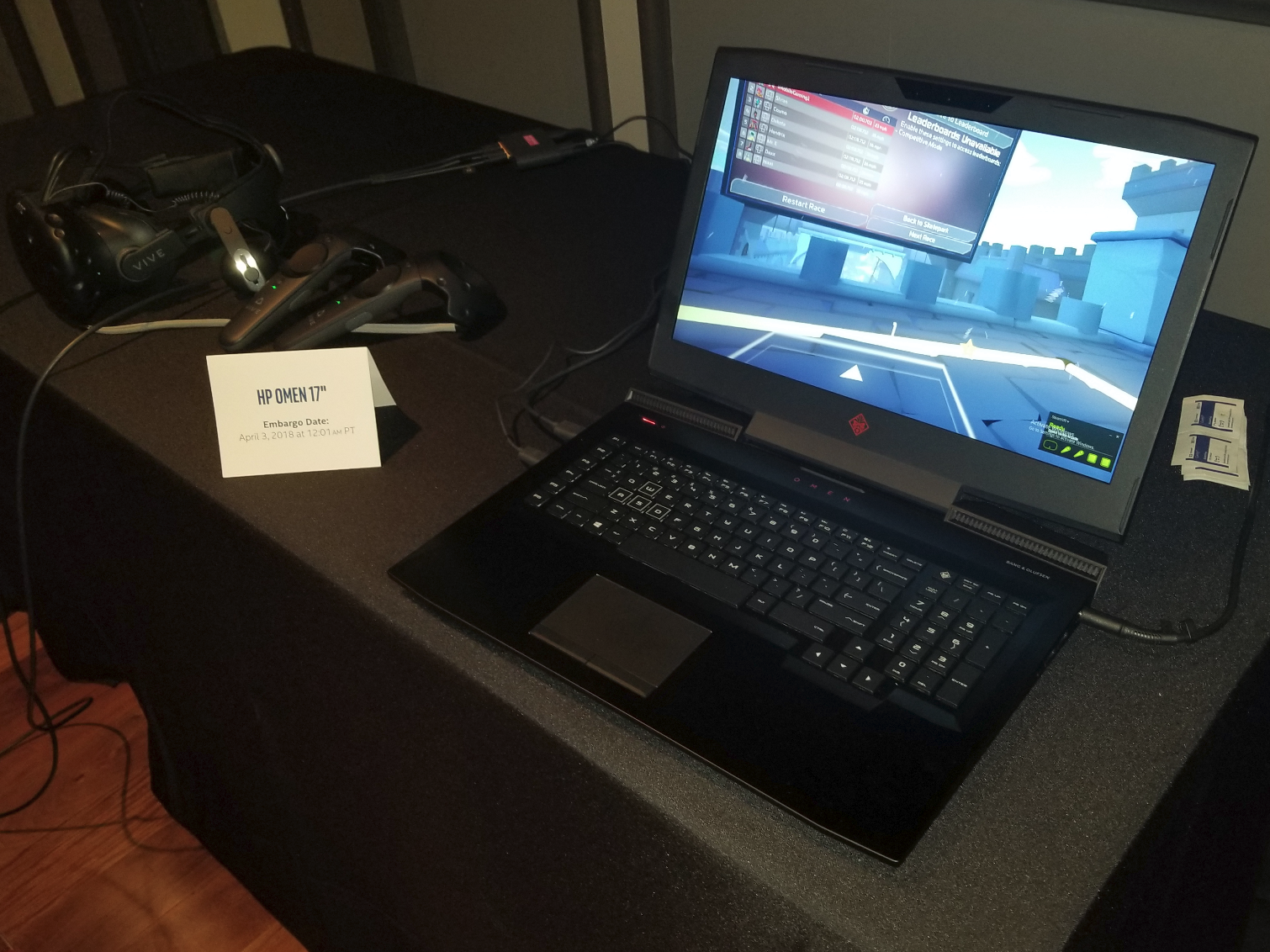
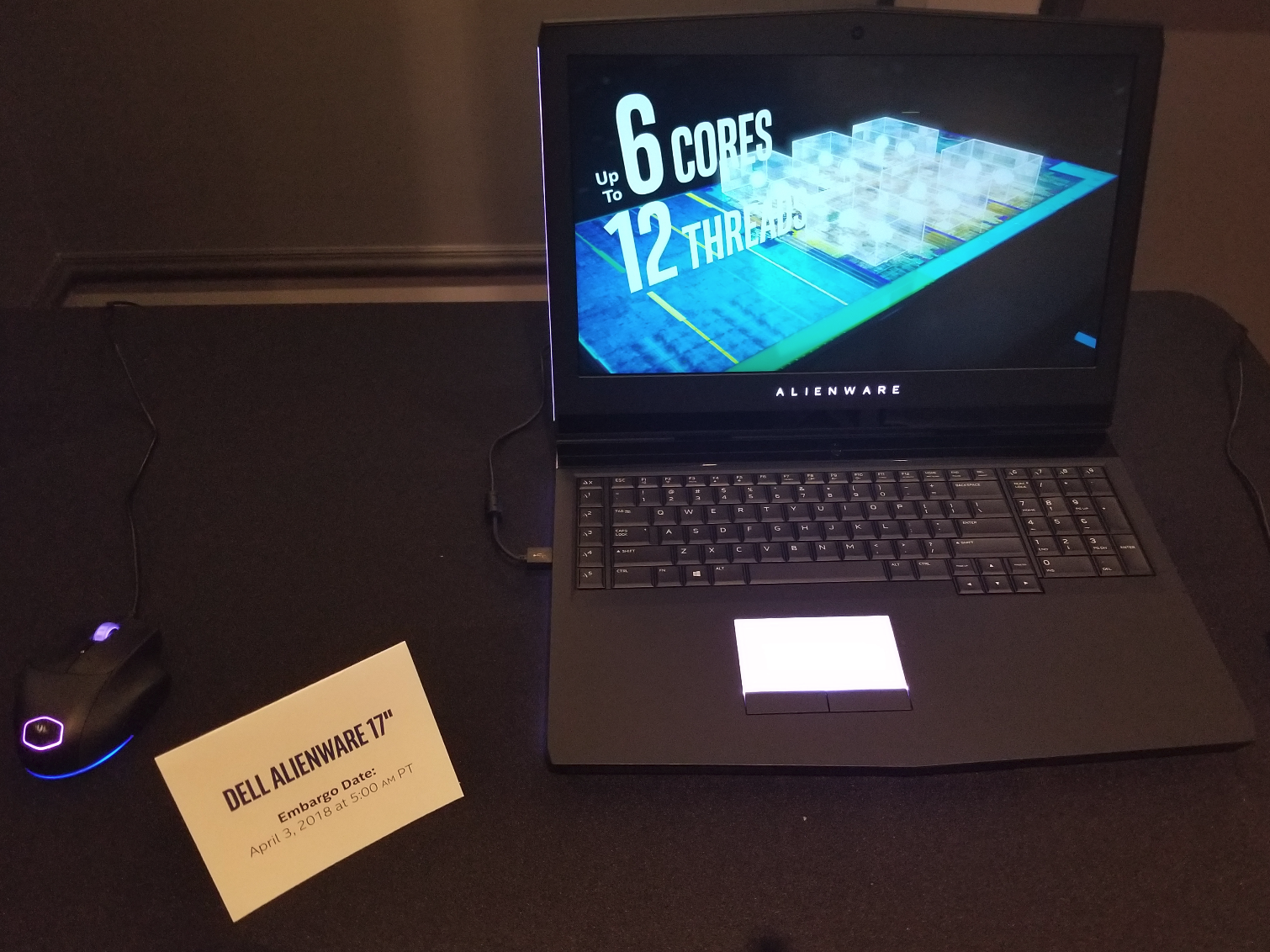

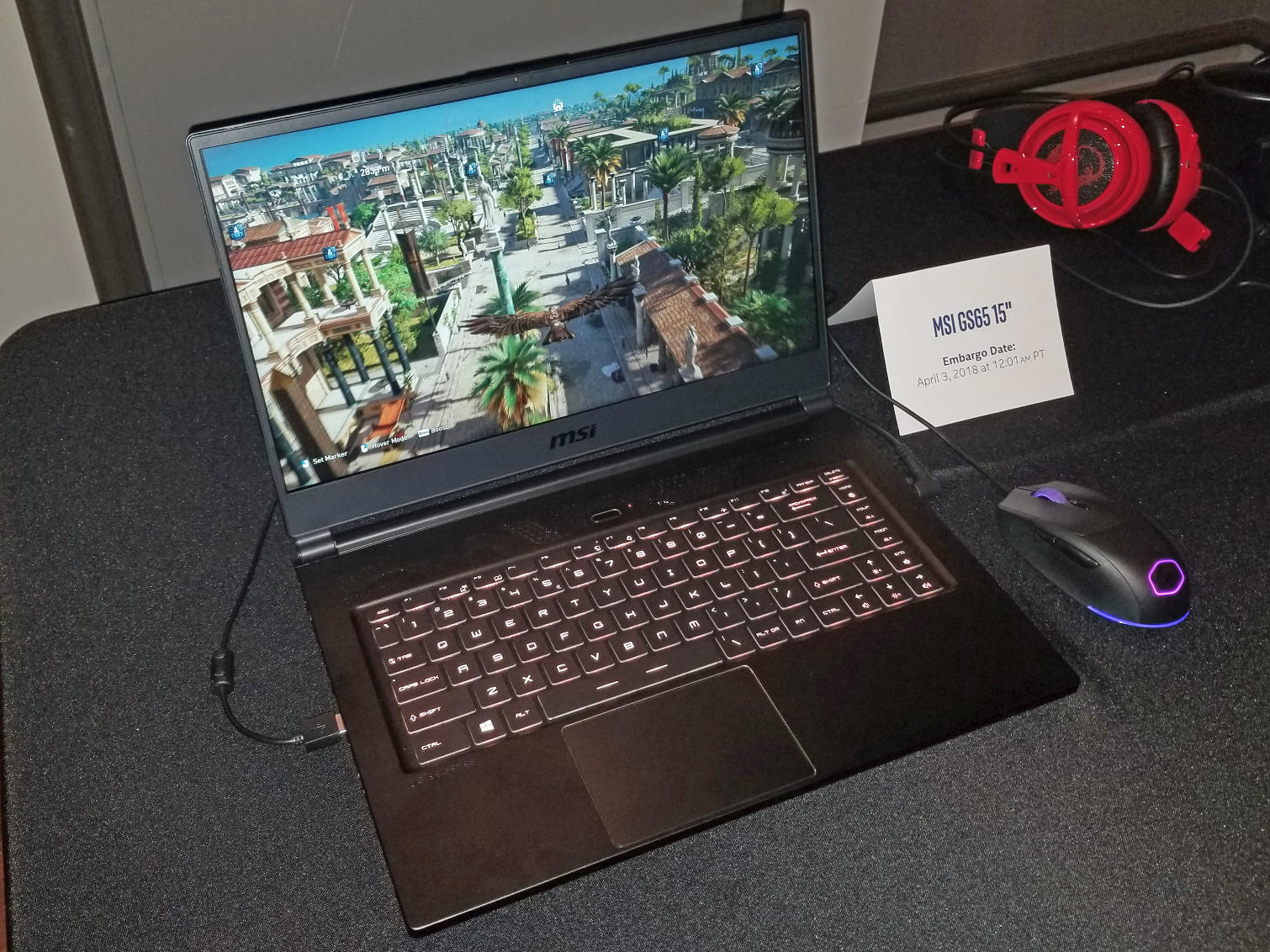
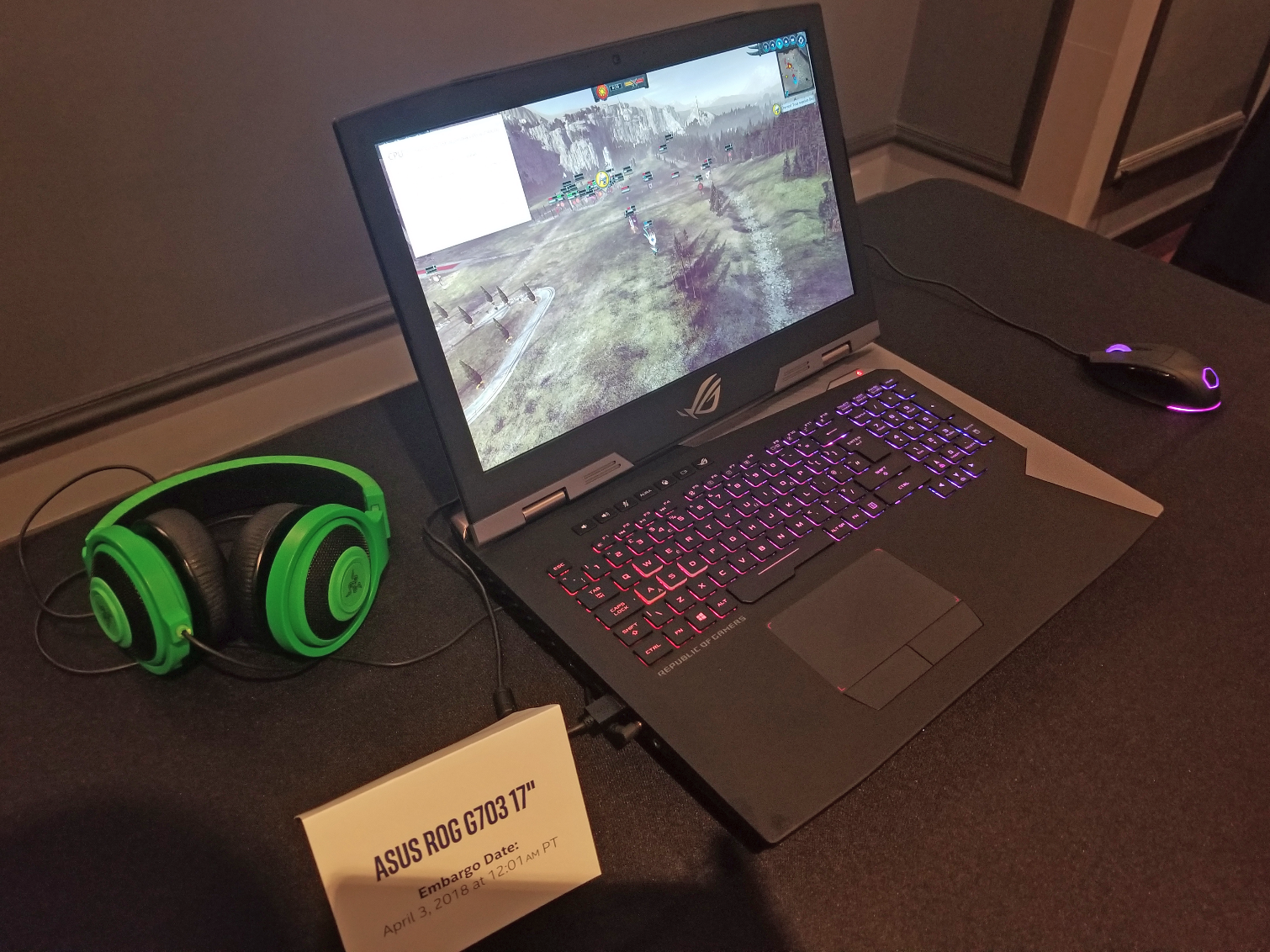
Finally, Intel had several notebooks that come bearing the new processors at its tech day in San Francisco. We've included pictures of some of the new designs for your perusal, but check our pages for listings of the specifications as each new offering is announced.
Thoughts
Intel's 14nm has been the longest-running node in Intel's history, but while we await 10nm with bated breath, the multiple 14nm iterations have paid dividends in terms of performance and power consumption. Intel's Kaby Lake Refresh models came packing the 14nm+ process, but the step up to 14nm++ with the new Coffee Lake processors has brought the highest frequencies, particularly in lightly-threaded applications, that we've ever seen in the notebook market. Adding in 50% more cores with the six-core processors should unlock even more performance in heavily-threaded applications, thus setting the new bar for high-end gaming and workstation laptops.
AMD's continuing pressure, especially as it works to establish a foothold in the laptop market, has obviously spurred Intel to make some radical adjustments to its product stack. That's good for everyone. For now, AMD lags Intel's core counts and frequencies in the laptop market, but its integrated Vega graphics should allow it to continue to carve out a portion of the lucrative gaming segment. AMD also has its own new Radeon Vega Mobile processors coming with HBM2 this year, which should reignite the competition between the two companies. However, that product will likely compete squarely with Intel's Vega-infused Kaby Lake-G processors, setting the stage for another interesting year in the CPU market.
Intel hasn't shared pricing information for the new processors yet, but given the Core i9's hefty core count and industry-leading frequencies, we fully expect devices wielding the new processors to come at a premium.
EDIT: Intel provided us with the price list shortly before publication:
| i9-8950HK (12M cache, 6 Cores, 12 Threads, 2.90 GHz) | $583 |
|---|---|
| E-2186M (12M cache, 6 Cores, 12 Threads, 2.90 GHz) | $623 |
| E-2176M (12M cache, 6 Cores, 12 Threads, 2.70 GHz) | $450 |
| i7-8850H (9M cache, 6 Cores, 12 Threads, 2.60 GHz) | $395 |
| i7-8750H (9M cache, 6 Cores, 12 Threads, 2.20 GHz) | $395 |
| i7-8559U (8M cache, 4 Cores, 8 Threads, 2.70 GHz) | $431 |
| i5-8400H, 8M cache, 4 Cores, 8 Threads, 2.50 GHz) | $250 |
| i5-8300H (8M cache, 4 Cores, 8 Threads, 2.30 GHz) | $250 |
| i5-8269U (6M cache, 4 Cores, 8 Threads, 2.60 GHz) | $320 |
| i5-8259U (6M cache, 4 Cores, 8 Threads, 2.30 GHz) | $320 |
| i3-8109U (4M cache, 2 Cores, 4 Threads, 3.00 GHz) | $304 |

Paul Alcorn is the Editor-in-Chief for Tom's Hardware US. He also writes news and reviews on CPUs, storage, and enterprise hardware.
-
pelegbn Why does Intel's i9 CPU lacks vPro support? Does this mean it wont support Intel's hardware based virtualization technology ?Reply -
AgentLozen i7-8850H (9M cache, 6 Cores, 12 Threads, 2.60 GHz)Reply
$395
i7-8750H (9M cache, 6 Cores, 12 Threads, 2.20 GHz)
$395
I wonder what the purpose of pricing these two CPUs the same is? Unless this is a typo. -
Dosflores Please welcome another messy Intel branding strategy: Core i5+, Core i7+, etc. The + sign means that the PC includes some kind of Optane product.Reply -
Zaporro How to sell a CPU For nearly 200% than normally, intel style:Reply
- make it "mobile"
- call it i9 even if it has same stats as i7-8700k
= profit -
bigdragon Hopefully these new 6-core CPUs find their way into a 2-in-1 tablet PC like the Yoga 730. I'm always irked when I see these capable products relegated to gamer systems.Reply -
logainofhades I am interested in the i7 6 core chips. I have been holding out, on a new laptop, for these. Hopefully we will see some decently priced models soon.Reply -
bit_user Enough of this tiny eDRAM nonsense - I want to see what a 72 EU HD Graphics (GT4) GPU can do with 4 GB of HBM2!Reply
Sure, it's not going to be equivalent to a 24 CU Vega, which has 3x as many floating point ALUs, but it should still offer tangible benefits over the tiny eDRAM and would free up DDR4 for exclusive use by the CPU.
As for the CPU, I really like what Intel has been doing with Coffee Lake: high boost for lightly-threaded workloads, and lots of cores for heavily-threaded ones. -
alextheblue Reply
I think you pretty much summed it up... bigger die size, more power, higher cost, would not remotely compete with their G series chips with 20-24 CU Vega.20854194 said:Enough of this tiny eDRAM nonsense - I want to see what a 72 EU HD Graphics (GT4) GPU can do with 4 GB of HBM2!
Sure, it's not going to be equivalent to a 24 CU Vega, which has 3x as many floating point ALUs, but it should still offer tangible benefits over the tiny eDRAM and would free up DDR4 for exclusive use by the CPU.
They'll eventually build something like this, but not until their own graphics are competitive. -
bit_user Reply
Yeah, but I think it'd be interesting to see what HD Graphics can do when not hamstrung by DDR4. eDRAM helps, but only so much.20854225 said:I think you pretty much summed it up... bigger die size, more power, higher cost, would not remotely compete with their G series chips with 20-24 CU Vega.
My intuition says it's not as efficient as GCN (beyond merely being smaller), but Intel does have a better process node and scores surprisingly well on OpenCL compute workloads. -
Clamyboy74 How to screw people over intel styleReply
*Release 7700hq and 7820hk*
*Release i5 8300h with the same cores*
*Laugh while people buy the i7 because branding*
